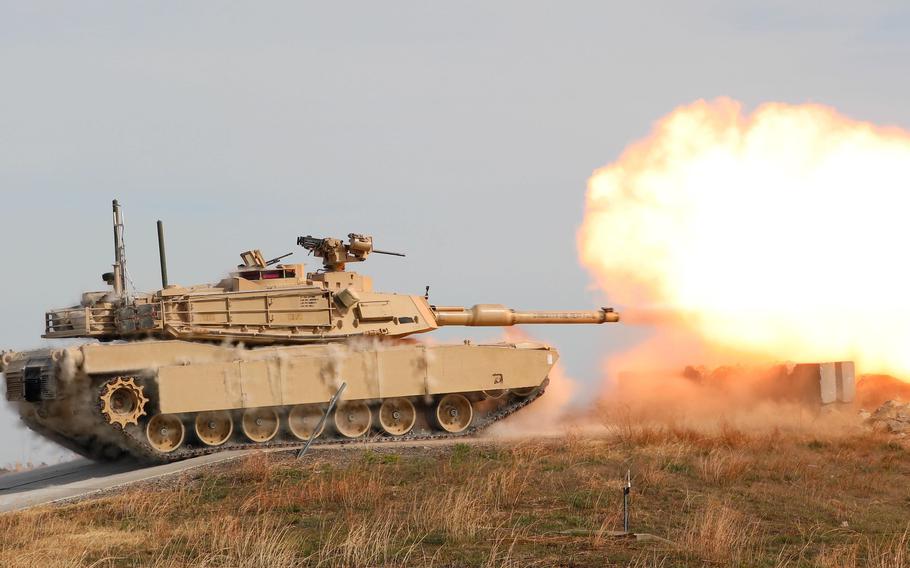
An M1A1 Abrams tank operated by soldiers with the 2nd Battalion, 70th Armored Regiment, 2nd Armored Brigade Combat Team, 1st Infantry Division fires over a barricade at the Douthit Gunnery Complex on Fort Riley, Kan., on Oct. 20, 2022. (Jared Simmons/U.S. Army)
WASHINGTON — The Defense Department is speeding up plans to send the U.S. military’s most sophisticated battle tank to Ukraine as the country braces itself for an expected increase in Russian attacks in the coming weeks, Pentagon officials said Tuesday.
Pentagon officials said in January that the U.S. would provide Ukraine almost three dozen M1A2 Abrams tanks, which is widely considered one of the best tanks in the world. But the M1A2 Abrams is highly complex equipment and requires regular maintenance — reasons why U.S. officials were initially hesitant to send those tanks to Ukraine.
On Tuesday, Pentagon officials announced a change in the plan. Ukraine instead will receive 31 M1A1 Abrams tanks that are being refurbished and fitted for conditions in the ongoing battle in the country’s eastern region. The M1A1 is a slightly older variant of the tank.
“After further study and analysis … [we] have made the decision to provide the M1A1 variant of the Abrams tank, which will enable us to significantly expedite delivery timelines and deliver this important capability to Ukraine by the fall of this year,” Air Force Brig. Gen. Pat Ryder, the Pentagon’s top spokesman, told reporters.
The first plan to send M1A2s required the tanks be procured from the defense industry through the Ukraine Security Assistance Initiative. The tanks would effectively need to be built using that plan and delay their delivery to Ukraine for more than a year, Ryder said.
With the warming weather in Europe stoking fears of a Russian spring offensive, Pentagon officials concluded it would be quicker to refurbish existing M1A1 tank frames that the U.S. military already has and build in configurations that are most suitable for battlefields in Ukraine. Ryder said the Ukraine variant will include a 120 millimeter cannon and .50 caliber machine gun.
“This is about getting this important combat capability into the hands of Ukrainians sooner rather than later,” he said.
The change in plan is expected to shave months off the delivery time for the Abrams tank. Sabrina Singh, a Pentagon spokeswoman, said in January that one of the reasons why officials decided initially to have defense contractors build new tanks is the U.S. military doesn’t have spare battle-ready tanks to send the Ukrainians.
The Abrams tanks — named for Army Gen. Creighton Abrams, a Vietnam War commander — have been in service for 40 years and include several variants. The U.S. has sold many variants to other countries, but none of those tanks include the classified technologies that are built into U.S. models -- such as armor and munitions made of depleted uranium, an extremely hard and resistant material.
Ryder confirmed Tuesday that the tanks to be sent to Ukraine will not have depleted uranium packages. He also acknowledged that Kyiv should also receive the Patriot missile system it’s getting from the U.S. ahead of schedule.
In all, Ukraine is getting three Patriot systems — one from the United States, one from Germany and one from the Netherlands. A group of about 100 Ukrainian troops have been training for months at Fort Sill, Okla., to learn how to use the sophisticated ground missile battery.
“We are confident that we will be able to get the Patriot there on an expedited timeline,” Ryder said, adding the Ukrainian troops being trained at Fort Sill are learning quicker than expected.
Since Russia invaded Ukraine in February 2022, the United States has committed almost $33 billion in military weapons and equipment to help Kyiv defend against Russian attacks. The most recent round of security aid was announced Monday and includes more ammunition, patrol boats, missiles, mine-clearing equipment, grenade launchers, thermal imagery systems and fuel tankers.